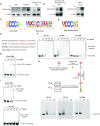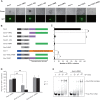Concurrent binding to DNA and RNA facilitates the pluripotency reprogramming activity of Sox2
- PMID: 32016422
- PMCID: PMC7144947
- DOI: 10.1093/nar/gkaa067
Concurrent binding to DNA and RNA facilitates the pluripotency reprogramming activity of Sox2
Abstract
Some transcription factors that specifically bind double-stranded DNA appear to also function as RNA-binding proteins. Here, we demonstrate that the transcription factor Sox2 is able to directly bind RNA in vitro as well as in mouse and human cells. Sox2 targets RNA via a 60-amino-acid RNA binding motif (RBM) positioned C-terminally of the DNA binding high mobility group (HMG) box. Sox2 can associate with RNA and DNA simultaneously to form ternary RNA/Sox2/DNA complexes. Deletion of the RBM does not affect selection of target genes but mitigates binding to pluripotency related transcripts, switches exon usage and impairs the reprogramming of somatic cells to a pluripotent state. Our findings designate Sox2 as a multi-functional factor that associates with RNA whilst binding to cognate DNA sequences, suggesting that it may co-transcriptionally regulate RNA metabolism during somatic cell reprogramming.
© The Author(s) 2020. Published by Oxford University Press on behalf of Nucleic Acids Research.
Figures







Similar articles
-
A role for mitotic bookmarking of SOX2 in pluripotency and differentiation.Genes Dev. 2016 Nov 15;30(22):2538-2550. doi: 10.1101/gad.289256.116. Epub 2016 Dec 5. Genes Dev. 2016. PMID: 27920086 Free PMC article.
-
The Sox2 transcription factor binds RNA.Nat Commun. 2020 Apr 14;11(1):1805. doi: 10.1038/s41467-020-15571-8. Nat Commun. 2020. PMID: 32286318 Free PMC article.
-
Transient activation of autophagy via Sox2-mediated suppression of mTOR is an important early step in reprogramming to pluripotency.Cell Stem Cell. 2013 Nov 7;13(5):617-25. doi: 10.1016/j.stem.2013.10.005. Cell Stem Cell. 2013. PMID: 24209762
-
Mechanism of Induction: Induced Pluripotent Stem Cells (iPSCs).J Stem Cells. 2015;10(1):43-62. J Stem Cells. 2015. PMID: 26665937 Review.
-
SOX2 and cancer: current research and its implications in the clinic.Clin Transl Med. 2014 Jul 4;3:19. doi: 10.1186/2001-1326-3-19. eCollection 2014. Clin Transl Med. 2014. PMID: 25114775 Free PMC article. Review.
Cited by
-
SOX2 interacts with hnRNPK to modulate alternative splicing in mouse embryonic stem cells.Cell Biosci. 2024 Aug 19;14(1):102. doi: 10.1186/s13578-024-01284-8. Cell Biosci. 2024. PMID: 39160617 Free PMC article.
-
Molecular basis for SOX2-dependent regulation of super-enhancer activity.Nucleic Acids Res. 2023 Dec 11;51(22):11999-12019. doi: 10.1093/nar/gkad908. Nucleic Acids Res. 2023. PMID: 37930832 Free PMC article.
-
Denaturing purifications demonstrate that PRC2 and other widely reported chromatin proteins do not appear to bind directly to RNA in vivo.Mol Cell. 2024 Apr 4;84(7):1271-1289.e12. doi: 10.1016/j.molcel.2024.01.026. Epub 2024 Feb 21. Mol Cell. 2024. PMID: 38387462 Free PMC article.
-
Unraveling mitochondrial piRNAs in mouse embryonic gonadal cells.Sci Rep. 2022 Jun 24;12(1):10730. doi: 10.1038/s41598-022-14414-4. Sci Rep. 2022. PMID: 35750721 Free PMC article.
-
Long non-coding RNAs: definitions, functions, challenges and recommendations.Nat Rev Mol Cell Biol. 2023 Jun;24(6):430-447. doi: 10.1038/s41580-022-00566-8. Epub 2023 Jan 3. Nat Rev Mol Cell Biol. 2023. PMID: 36596869 Free PMC article. Review.
References
Publication types
MeSH terms
Substances
LinkOut - more resources
Full Text Sources
Molecular Biology Databases

